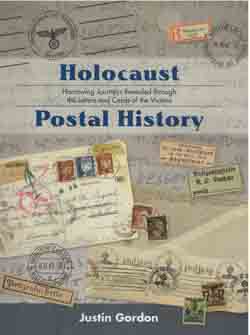Holocaust Postal History by Justin Gordon; Six Point Watermark;© 2016; ISBN 9780997-840100; 138 pages plus glossaries, bibliography and index.
By Donald H. Harrison

 SAN DIEGO – The author of this richly illustrated book deserved compliments for his persistence as a collector, his clarity as a writer, and his ability as a researcher. No matter how many books on the Holocaust that you’ve read (and I’ve read and reviewed many), this volume will provide you with a deeper understanding of the bureaucratic structure of the Nazi killing machine, while offering a glimpse into the hope and fear of the Jewish victims.
SAN DIEGO – The author of this richly illustrated book deserved compliments for his persistence as a collector, his clarity as a writer, and his ability as a researcher. No matter how many books on the Holocaust that you’ve read (and I’ve read and reviewed many), this volume will provide you with a deeper understanding of the bureaucratic structure of the Nazi killing machine, while offering a glimpse into the hope and fear of the Jewish victims.
In the preface, Gordon explains that as a “postal historian, I collect not only the stamps but also the envelope and its markings, any enclosed correspondence, and all attached items as an intact unit. I also conduct research into the origin of the letter, where it was sent, and whether or not it arrived. Every marking on a cover is a piece in the puzzle documenting its journey. Often the contents of the letter or postal card add information about the person who sent the item and the historical period.”
The book begins with labels attached to the back of envelopes by anti-Semites before Adolf Hitler took office. One warns people not to buy from Jews or to shop in their stores, while another, from the “German National Protection and Defense League” denounces various general circulation newspapers as being written by Jews for Jews, and are thus Jewish newspapers.”
Next, we are introduced to Nazi cancellations, censor tapes, and postal warnings and regulations particularly as they affect Jews. For example, one government-printed postcard warns Austrian Jews that they are not permitted to vote in the plebiscite on Anschluss with Germany. Another required Jewish women writing letters to identify themselves with the middle name “Sara” and Jewish men to adopt the middle name “Israel.” Jewish dentists and doctors, no longer permitted to treat non-Jewish patients, could identify themselves on letterheads only as “caretakers of the teeth” and “caretakers to the sick.” Similarly, Jewish lawyers had to downgrade their status to “legal consultants.” Gordon includes postal examples of letters and postcards obeying these discriminatory laws.
Prior to Kristallnacht, the Nazis held an anti-Semitic postal exhibition called Der Ewige Jude (The Eternal Jew) at which attendees could purchase specially postmarked envelopes as souvenirs.
Outside Germany, some societies were formed for the protection of Jews under Nazi rule, and Gordon includes postal covers from these organizations in his book as well.
After World War II and the creation of Jewish ghettos by the Nazis, we see the postmarks stamped onto envelopes by area censors. We also read some postcards that were allowed to go through to their destination by censors, and others that were rejected. Any letters written in Yiddish or Hebrew automatically were rejected. Censors required everything to be written in German—even by people living in occupied countries.
In some Nazi-occupied cities, Jewish councils were required to screen the mail. Postal cards bearing their identification, such as one from the Alteste der Juden (the Jewish Elder) in Lizzmannstadt (the Nazi name for Lodz, Poland) are included among the illustrations.
From ghettos, the book follows the Nazi’s murder machine to the work camps, concentration camps, and extermination camps, some of which had pre-printed postcards on which inmates were directed to lie that everything was just fine before they were marched off to the gas chambers.
The book concludes with cards of hope from the Displaced Persons (DP) camps, where survivors were gathered after the defeat of Nazi Germany. And, for good measure, there are initial postal issues from Israel, where many of the survivors at last found permanent refuge.
Whether philatelists or not, readers will be fascinated and moved by this very personal display of Holocaust history.
*
Harrison is editor of San Diego Jewish World. He may be contacted via donald.harrison@sdjewishworld.com